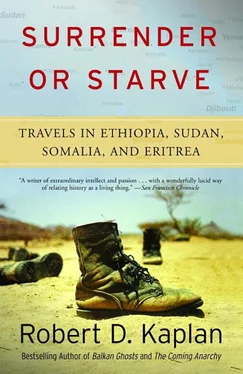This fear was borne out by subsequent events. Even the deaths of as many as one million peasants in the 1984–1985 famine did not cause the Dergue to alter its policies in the slightest. In fact, the famine appeared only to stiffen the regime’s resolve. The resettlement of Tigreans and the villagization of Oromos were accelerated, and a July 1985 offensive against guerrillas in Eritrea resulted in the heaviest fighting there of the decade. Consequently, although the drought had ended by mid 1985, the structural food deficit kept growing, according to USAID. With production stagnated, the grain shortfall in 1990 in Ethiopia is expected to be 2.5 million tons, compared with a 1.7 million ton shortfall during the height of the famine. USAID, fed up with the state of affairs in Addis Ababa, phased down its Ethiopia operation in 1986, leaving only one, small feeding program of 20,000 tons in place. The decision was greeted without a murmur of protest from the U.S. public—which already had lost interest in the issue—or from liberal Democrats, such as Senator Edward M. Kennedy, who had tired of extending the olive branch to a regime that refused to learn from experience. The formation of a full-fledged, ruling communist party (the Workers’ Party of Ethiopia), the regime’s conversion to a “socialist democracy,” its continued appetite for war, and a failure to countenance any economic reforms even in the wake of a famine only seemed to vindicate the administration’s consistently negative attitude toward the Dergue. USAID administrator M. Peter McPherson—President Reagan’s special adviser on the famine emergency—remarked to me that Mengistu’s refusal to ever meet with McPherson was like “a badge of honor.”
Not only was the Ethiopian government’s policy a disincentive to aid, but so was the government’s public attitude toward the donors. In A Year in the Death of Africa, author Peter Gill accused the RRC commissioner, Dawit Wolde Giorgis, of “a directness of manner that bordered on rudeness.” Gill, a British television reporter whose book was devoted to aid agency politics in 1984, wrote that Dawit “produced an unnerving moral equation between rich Governments in the West and the miserable poor in his own country. It was a formula that seemed at times to exclude his own government from further obligation.”
Dawit’s superiors in the Dergue appeared even more impervious to his warnings of impending disaster than did the Western governments he always was ready to criticize. The louder the RRC’s cries for help got, the more preoccupied the Dergue became with the war, the formation of the party, and the coming anniversary celebrations. How were Western governments supposed to get worked up about what the RRC was saying if the RRC’s own bosses weren’t?
Originally, the RRC might have been created with the intention of forestalling future famines. But by 1984, the RRC had become a mere vestige of the emperor’s powerless westernized elite, given the task of collecting relief donations for a regime that spent half its budget on fighting wars in collaboration with the Soviet Union. The famine was good business for the Dergue. A port fee of $12.60 was charged for each ton of donated grain. This replaced coffee as Ethiopia’s biggest hard currency earner. The United States paid $5 million just to have its first 400,000 tons pass customs inspection. It appeared far from coincidental that the costliest-ever government offensive against the Eritrean guerrillas was launched in July 1985, on the heels of the massive influx of relief supplies from the West.
In late 1985, RRC commissioner Dawit defected to the very country he had been the most publicly critical of—the United States. Dawit, who had defended Mengistu to the point of justifying the brutal expulsion of fifty thousand people from a relief camp in Gondar the previous April, lost no opportunity once in the United States to criticize the Ethiopian leader. At an East-West Round Table meeting in New York in late 1986, Dawit said, among other things:
Mengistu’s dream and primary objective is to make Ethiopia the first African Communist country, in the fullest sense, by restructuring the national social fabric and creating a regimented, controlled society….
His [Mengistu’s] indifference to the emergency aggravated the effects of the drought, leading to mass death, starvation and migration at the earliest stage of the crisis.
After berating the West for years for not giving enough aid, Dawit was quoted in The Wall Street Journal Europe (April 1986) as stating that the aid kept an inhuman regime in power: “Without this help there would have been a bloody chaos which would have resulted in the removal of Mengistu and his henchmen.”
The Reagan administration’s attitude toward Ethiopia thus had been vindicated by the Marxist government’s top official for dealing with the famine. Rarely in the Third World was the conservative position so authoritatively proven correct. It’s a pity more conservatives weren’t paying attention. Few of them wrote about it. Like the liberals, most conservatives were preoccupied with other issues by the time of Dawit’s defection.
In early 1986, Dawit’s top assistant in the RRC, Berhane Deressa, followed Dawit into exile. Approximately eighty Ethiopian officials had defected by then. In Africa, however, officials flee their own countries all the time, and they never are referred to as “defectors.” The media’s instinctive use of the word for this high-level exodus was perhaps the most eloquent proof of Ethiopia’s transformation into a communist society, a transformation that was completed in the midst of the Western famine relief effort.
Emergency aid meant people, and in late 1984 Ethiopian authorities were forced to allow an influx of Westerners into Addis Ababa—relief workers, government officials, journalists, and celebrities—which in terms of relative size and suddenness was unprecedented in the Eastern bloc. The Hilton Hotel, whose occupancy rate normally hovered around 50 percent, was filled to capacity for the next nine months. An article of faith among many in the Hilton lobby during this period was that the very presence of so many people like themselves from North America, Western Europe, and the rest of the free world would work to moderate the foreign and domestic policies of the regime. Ethiopia, it was said, was being forced by the famine to open itself to Western influence. Seldom have so many people been so wrong in such a naïve fashion about what was going on all around them.
“In fact, it is to Alice in Wonderland that my thoughts recur in seeking some… parallel for life in Addis Ababa,” wrote Evelyn Waugh, in his evocation of 1930s Ethiopia, Remote People. Waugh might have felt a tinge of déjà vu had he been able to pay a return visit a half century later. The nest of restrictions imposed by a totalitarian system, combined with the insidious effects of local history, placed this throng of unknowing intruders from the West in a politically watertight compartment, with distorting mirrors at every turn.
The physical setting of the Ethiopian capital and the manner in which it was built were elements in this deception. Addis Ababa (Amharic for new flower) was built by Menelik II, starting in 1889. As the first Amhara emperor, Menelik wanted to shift the focal point of the empire southward from Tigre to the highlands of Shoa. The site chosen was the plain beside Mount Entoto. But at an altitude of 8,000 feet, the scarcity of wood presented a problem. It was solved in 1900 by the introduction of the fast-growing eucalyptus tree from Australia. As a result, the first sensation a traveler had upon arriving in Addis Ababa was one of bodily well-being, brought about by the invigorating mountain climate and the shade and ubiquitous fragrance of the eucalyptus trees. Diplomats and aid specialists accustomed to the leaden heat and blinding sunlight of other African and Middle Eastern capitals found “Addis” a godsend. It was like arriving at a hill station in the Himalayas after weeks on the hot, teeming plains of the subcontinent. Gone was the irritability stirred by dusty, clammy skin and a shirt drenched with sweat at ten in the morning. One’s mood was vastly improved and thus made a person better disposed toward his or her hosts.
Читать дальше












